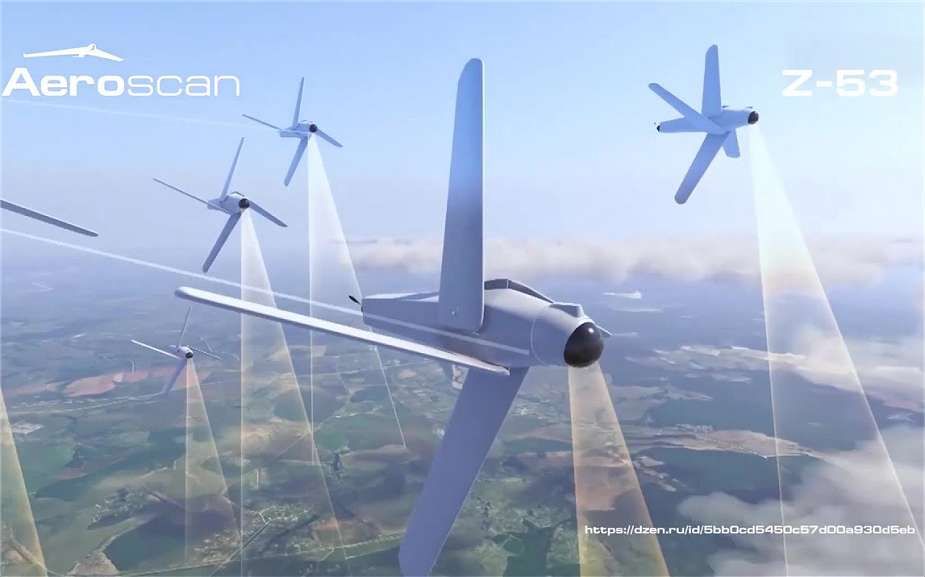Breaking news
Russia Introduces Izdeliye-53 Z-53 Kamikaze Drone with Automatic Guidance System.
In a significant development in military drone technology, Russian forces have reportedly started deploying a new version of the “Lancet” kamikaze drone, known as the “Izdeliye-53 or Z-53” According to Russian sources, the use of these advanced drones commenced in October 21, 2023.
Follow Army Recognition on Google News at this link

The design of the Z-53 is similar to the Lancet kamikaze drone but fitted with an automatic guidance system. (Picture source Aeroscan)
The “Izdeliye-53” or “Z-53” is distinguished by its automatic guidance system, which is capable of autonomously identifying and distinguishing between different types of targets, potentially increasing the accuracy and success rates of strikes.
The introduction of the Izdeliye-53 or Z-53 drone represents a notable advancement in unmanned aerial warfare. This drone is equipped with a sophisticated guidance system that allows it to autonomously select and engage targets, a feature that marks a significant step forward from earlier models. While the full capabilities of the drone are not yet publicly known, the reported ability to autonomously identify targets suggests a high level of technological sophistication.
The Izdeliye-53/Z-53 was unveiled at the Army-2023 defense exhibition near Moscow in August 2023. A promotional video released by the manufacturer highlights the drone's unique geometric design, featuring four large wings mounted at 45-degree angles on the front, a departure from the traditional X configuration. These wings unfold during launch, and notably, the drone lacks rear stabilizer winglets. Propelled by a rear-facing propeller, the Izdeliye-53 is equipped with a prominent, downward-facing camera that plays a crucial role in environmental mapping and target acquisition.
With a payload capacity of up to five kilograms, the Z-53 is engineered to operate in swarms, communicating and coordinating among themselves to locate and designate various ground targets. These targets range from enemy anti-aircraft and rocket artillery positions to armored units. This represents a significant advancement from the current-generation Lancet drones.
In terms of deployment, the Z-53 drones differ markedly from their predecessors. Instead of being launched from specialized pneumatic rails, they are released from compact, ground-based tubes, akin to mortar systems. This design allows for ease of transport and deployment, as the drones can be carried either in their tube launchers or in 2x2 battery formations using light vehicles. The multifunctional transport tubes serve not only for storage and transportation but also as the launch mechanism for the UAVs, eliminating the need for field assembly.
As of now, the deployment of the “Izdeliye-53” drones is not widespread. Russian sources indicate that the current use is primarily for testing purposes, particularly for assessing their effectiveness in mass synchronized swarm strikes. This strategy could potentially allow for overwhelming air defenses through sheer numbers and coordinated attacks.
Furthermore, the Institute for the Study of War (ISW) reported on October 24 that Russian forces allegedly used another new drone, the “Italmas” (also known as “Izdeliye-54”), during a strike in Kyiv Oblast. This suggests a broader strategy of integrating more advanced unmanned systems into Russian military operations.
The ISW has also assessed that the Russian command might be banking on the use of a large number of strike drones to overpower Ukrainian air defenses. However, there are concerns about the effectiveness of these drones against critical military targets, given their relatively small payload capacity, reportedly between three and five kilograms.
This development in drone warfare indicates a shift in military tactics, with a growing reliance on unmanned systems for precision strikes. The effectiveness of these new drones, particularly in terms of their impact on the ongoing conflict and their ability to challenge existing defense systems, remains to be seen.
Defense News November 2023


























